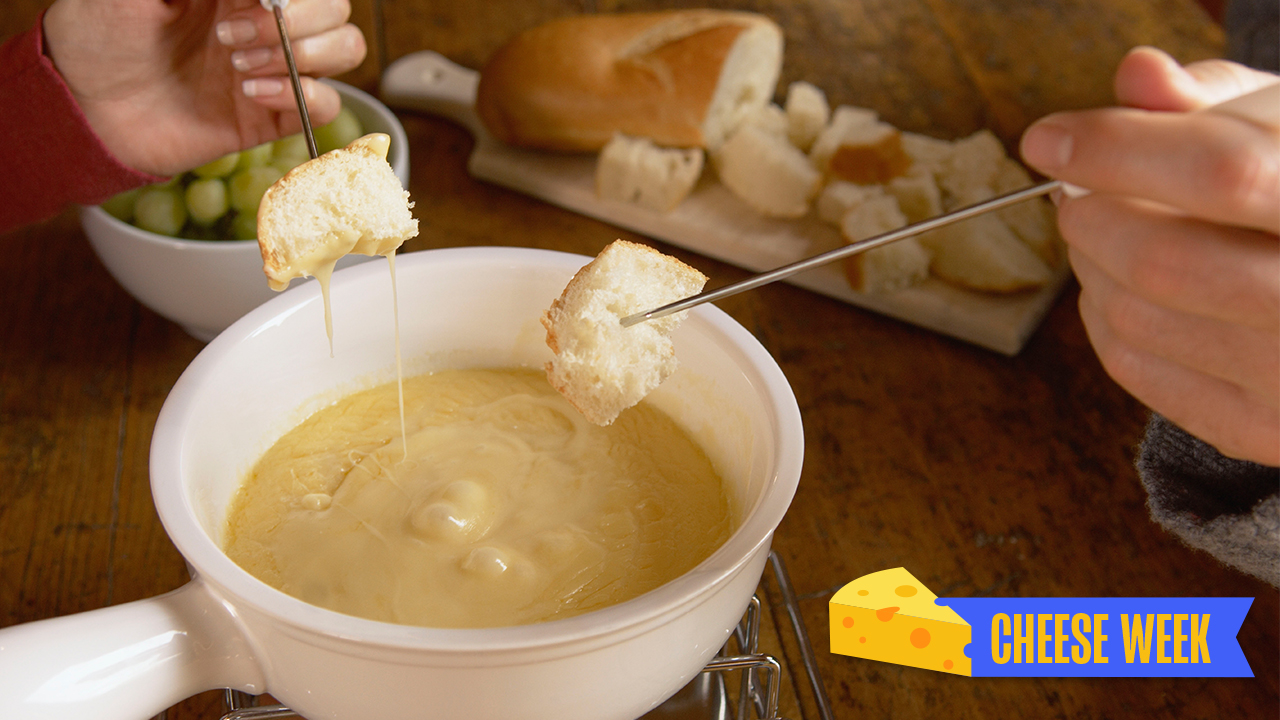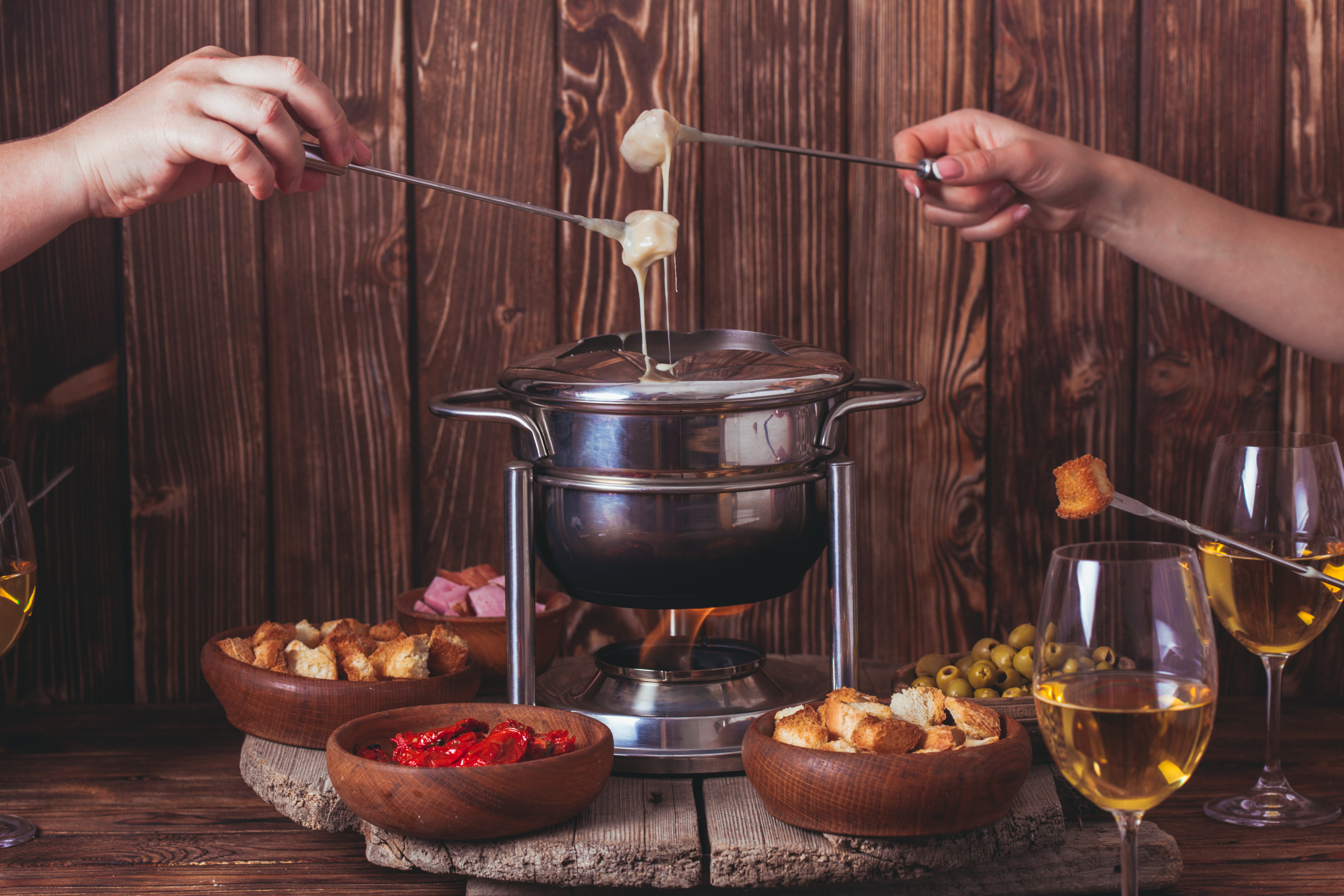Bring Back Fondue Dinner Parties, The Most Maligned Of Cheese Experiences
Welcome to Cheese Week, The Takeout's weeklong praise of cheeses.
Fondue pots are the pit bulls of the kitchen appliance community. Misunderstood, cast out, villainized, they stand accused of the most grievous of sins: taking up space and enabling kitsch.
We don't know where our fondue pot came from—all we know is it ended up at Goodwill. Most likely it was dropped off there during a manic fit of tidying up, or possibly purged in anticipation of a move. Regardless, it's gone, and when it finally arrived in Goodwill's home goods department, it was likely not the only set available for purchase there.
You can point to the ever-growing number of abandoned fondue sets as evidence that the generations since the '60s have turned their backs on the once-loved Swiss dining tradition. The fondue kits that litter garage sales and thrift stores are trotted out as confirmation that subsequent generations aren't as much fun as our rollicking, sexually liberated, free cheese-dunking predecessors.
In reality, it's not that younger generations hate fondue—although certain individuals, including The Takeout's staff—certainly take issue with it. It's more that we reject the idea that we need to store one more goddamned kitchen appliance in our homes in order to enjoy it.
The revolution will be melted
Like many foods seized upon and elevated by American suburbia, fondue claims humble beginnings. As the story goes, 17th-century Swiss peasants would dip stale bread into melted cheese, creating enough of a culinary fuss that in the 1930s, the dish was awarded the ultimate distinction of serving as Switzerland's national food. In 1964, the Swiss introduced Americans to fondue by featuring it in their pavilion at the World's Fair in New York where it caught on, becoming one of the foods to define that American decade.
Of course, this is only the story the Swiss want you to hear.
Further investigation reveals that the narrative includes significantly more mobsters than one might expect. After World War I ended, Swiss cheese makers realized they were dealing with a product surplus. To compensate, they agreed not to compete with each other in the market. Together they formed the Swiss Cheese Union, which NPR refers to as "an OPEC for cheese."
This cheese alliance persisted through the 1990s, managing Swiss dairy production, regulating prices, and controlling which cheeses could be made domestically. Smaller distributors were denied licenses to sell their wares, leading to allegations of government corruption. After a Swiss cheese official was sent to jail, the union collapsed, leaving the Swiss free to hawk their products as they pleased.
But decades before the implosion, when the union was still in its prime, the alliance realized that controlling the supply-side wasn't enough. To fully capitalize, they needed to increase demand for their product by tapping into America's growing cheese market. And to do this, they needed a dish capable of convincing Americans to buy shit-tons of cheese.
The timing couldn't have been better. America in the 1960s was marked by social and political unrest, increasing community, and decreasing formality. Women returned to work, reducing the amount of time available for meal prep and execution, but improving the amount of money a household could earn. Airline travel became mainstream and foreign foods domestically accessible. At the same time, downhill skiing began hitting the mainstream, with half the world's known ski areas popping up during the 1960s.
For the Swiss Cheese Union, rising disposable incomes coupled with the popularization of a beloved national sport provided the perfect climate in which to hawk their cheese. In the 1970s, they distributed ads featuring what can only be described as ski porn—images of healthy, beautiful people, fresh from the slopes, huddled around a fondue pot in their mid-century ski sweaters. The message was clear: Fondue is a healthy, Swiss tradition, guaranteed to keep you warm and satisfied as you chat with similarly attractive, athletic people.
The problem with kitsch
Those Swiss cheese mobsters proved adept advertisers, and fondue dinner parties ruled the '60s and '70s. The dish became synonymous with the Swinging Sixties—so much so that a quick Google search suggests that some people are wary of attending fondue parties, believing them to be a front for key parties.
But even if that misguided person wanted to attend a fondue party today, they'd have a hard time finding one. Calls to attend informal potlucks and sit down dinners are common, but receiving an invitation to dip assorted vegetables, meats, and carbohydrates into pots of melted cheese is a rarity. Why? Some of the fault surely lies with all those fondue pots abandoned at thrift stores across the country, but it's possible to make the dish without the associated appliance.
And it's not like there's not an appetite for this particular culinary experience. Adam Guillaume, Director of Operations at Geja's Café—a Chicago fondue institution—says his restaurant has maintained their customer base by updating the dish to accommodate modern health concerns, allergies, and dietary restrictions. Four years ago, Geja's began offering gluten-free bread and saw a spike in its business. They've since experimented with non-dairy and vegan cheeses, though those initiatives were slightly less successful. Today, vegans and the lactose averse are welcome to bring their own non-dairy chocolate to the restaurant and Geja's will happily melt it for them.
Over at Chicago restaurant Table, Donkey And Stick, the attitude toward fondue is just as enthusiastic, albeit slightly less traditional. The menu is built around Alpine drinking and dining traditions and it used to offer a fun take on fondue—a soft Swabian pretzel paired with a cauliflower and Comté cheese dip. The option was well-received, but owner Matthew Sussman points out that it's difficult to integrate fondue into a larger menu. He says, "It's kind of hard to eat a small pot of fondue, and once you're eating a pot of fondue, it's hard to eat anything else."
Guillaume says he can understand some of the misconceptions around fondue, specifically people's reticence to pay for a meal they're technically cooking themselves. But he believes fondue's real value is in its ability to bring people together "to forget about life and connect with each other."
When people take issue with fondue, the problem is usually not the taste. Traditional fondue consists of cheeses—usually varieties like Camembert, Taleggio, Beaufort, Fontina, and Emmental—combined with substances such as white wine, garlic, and black pepper over very low heat. These are not ingredients most people would protest. Rearrange the atoms and you have yourself a wine and cheese fête. Change them again and you have chips and queso, fondue's more casual, southern cousin.
The exact reason why modern Americans fail to embrace fondue is tough to pin down, but it usually comes back to kitsch. The sentimentality of it all makes us uncomfortable. Fondue parties are too nostalgic, too innocent, and too specific to one demographic, one type of experience. Even if we like fondue as a dish, the experience of throwing the party feels like a novelty, a cute throwback. It feels a little like a performance. And there's always a small chance one of your guests might set your house on fire.
But food has never been more performative than the present. We make meals just to take pictures of them and post them on Instagram. We freely share information about our diets, our cleanses, our meal prep. The Swiss Cheese Union sold Americans on fondue by highlighting its aspirational qualities. "Eat fondue and you will be popular, attractive, and athletic!" If ever there was a dish designed for social media, it's fondue.
Everything is better when it's dipped in #cheese fondue! #cheeseplease#Repost 📸: @oldpasadena pic.twitter.com/oojPTxSHMs
— The Melting Pot (@TheMeltingPot) January 3, 2019
The last few years indicate that culturally speaking, the public is hungry for throwbacks. Anxiety levels are mounting and we're starving for entertainment that evokes nostalgia, that makes us feel the way we did when we were younger, more innocent, less exhausted. It's why studios are rebooting shows like Charmed, Dynasty, Murphy Brown... [inhale]... Will & Grace, and Roseanne. It's why we keep watching The Office, even thought we know every line by heart. It's comfort food for an uncomfortable time. Maybe now, during the era of reboots, it's time to bring back fondue.

